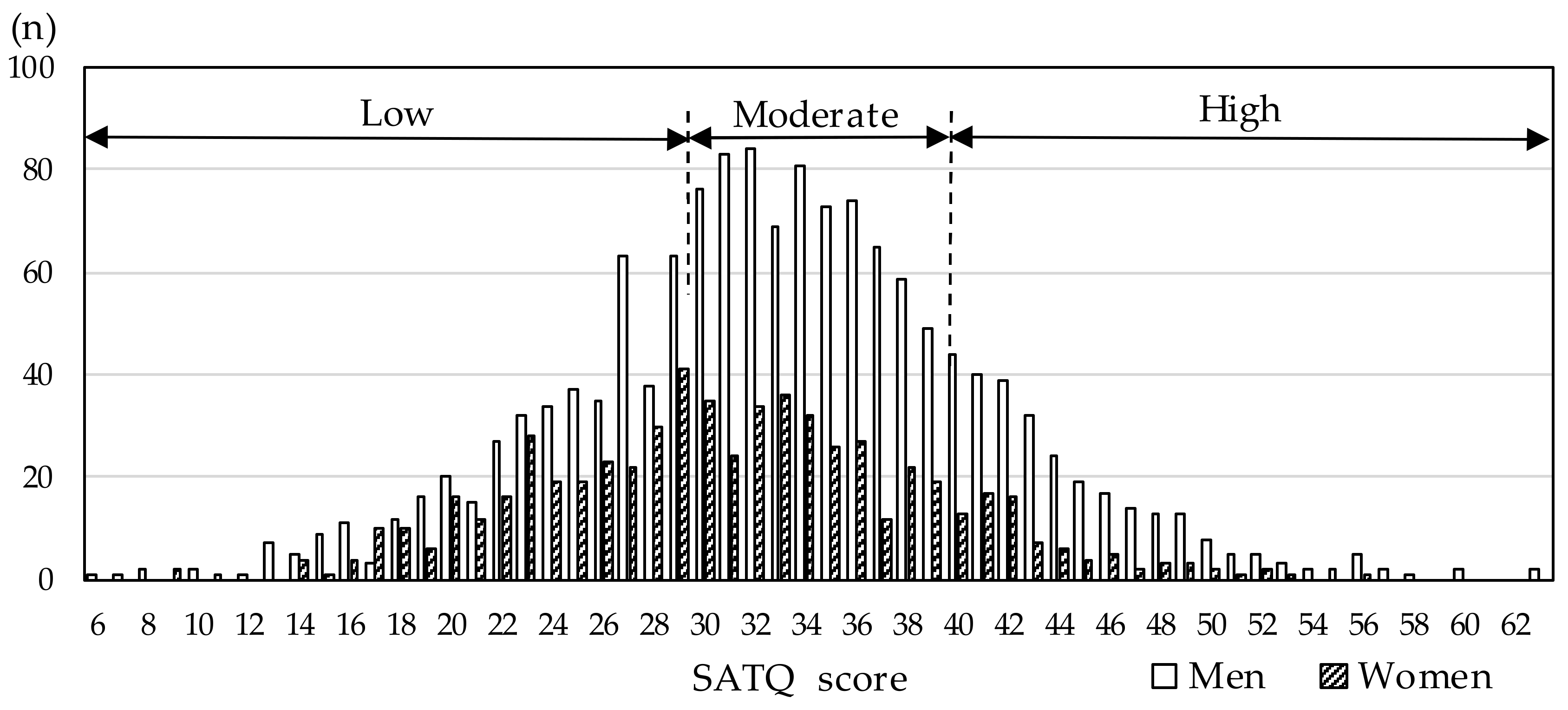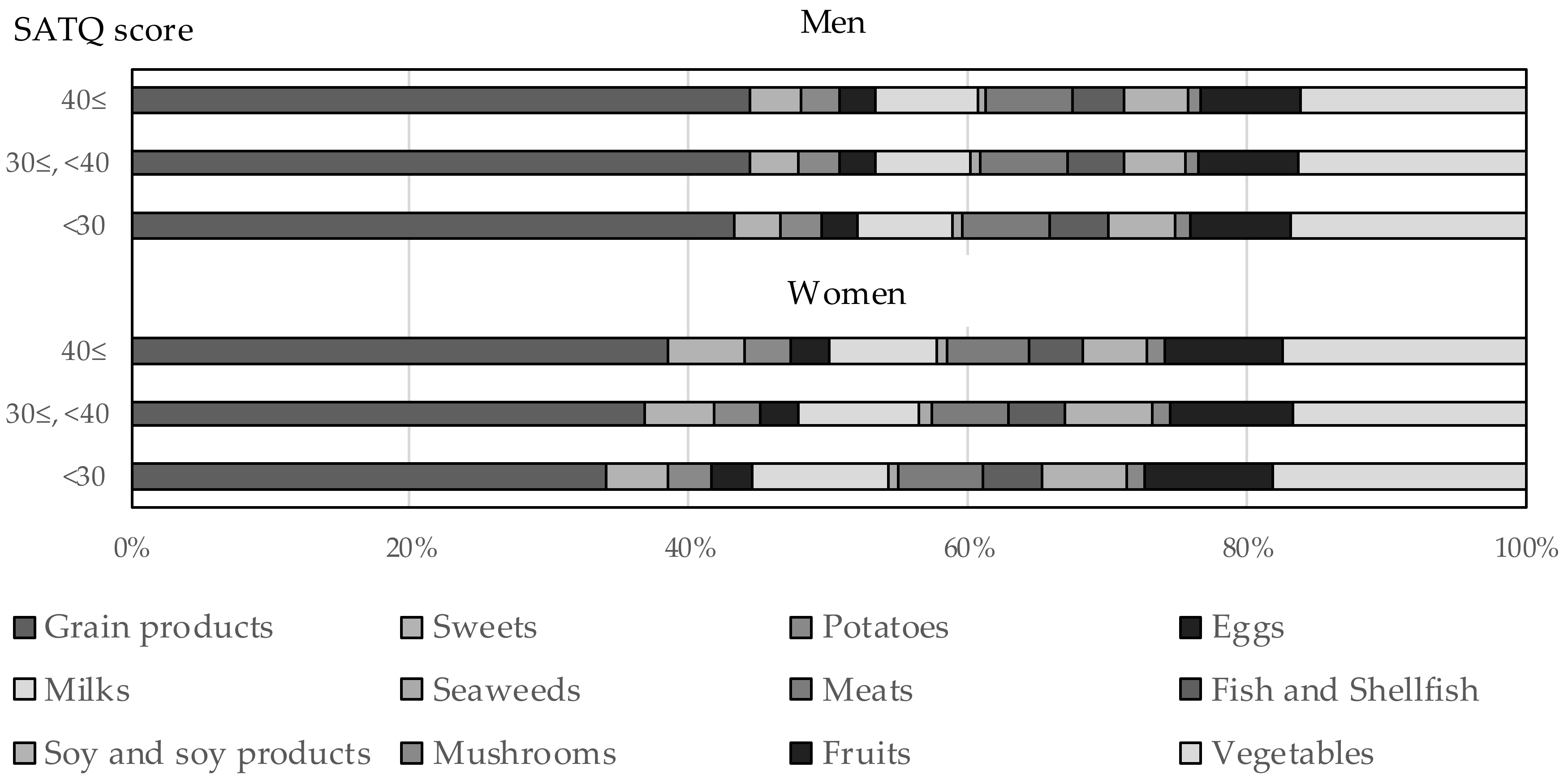Association between Dietary Intake and Autistic Traits in Japanese Working Adults: Findings from the Eating Habit and Well-Being Study
Abstract
1. Introduction
2. Materials and Methods
2.1. Study Design and Participants
2.2. Measurement
2.3. Statistical Analyses
3. Results
4. Discussion
5. Conclusion
Supplementary Materials
Author Contributions
Funding
Acknowledgments
Conflicts of Interest
References
- Lord, C.; Bishop, S.L. Recent advances in autism research as reflected in DSM-5 criteria for autism spectrum disorder. Annu. Rev. Clin. Psychol. 2015, 11, 53–70. [Google Scholar] [CrossRef] [PubMed]
- Baron-Cohen, S.; Wheelwright, S.; Skinner, R.; Martin, J.; Clubley, E. The autism-spectrum quotient (AQ): Evidence from Asperger syndrome/high-functioning autism, males and females, scientists and mathematicians. J. Autism Dev. Disord. 2001, 31, 5–17. [Google Scholar] [CrossRef] [PubMed]
- Kanne, S.M.; Wang, J.; Christ, S.E. The Subthreshold Autism Trait Questionnaire (SATQ): Development of a brief self-report measure of subthreshold autism traits. J. Autism Dev. Disord. 2012, 42, 769–780. [Google Scholar] [CrossRef] [PubMed]
- Nishiyama, T.; Suzuki, M.; Adachi, K.; Sumi, S.; Okada, K.; Kishino, H.; Sakai, S.; Kamio, Y.; Kojima, M.; Suzuki, S.; et al. Comprehensive comparison of self-administered questionnaires for measuring quantitative autistic traits in adults. J. Autism Dev. Disord. 2014, 44, 993–1007. [Google Scholar] [CrossRef]
- Dell’Osso, L.; Gesi, C.; Massimetti, E.; Cremone, I.M.; Barbuti, M.; Maccariello, G.; Moroni, I.; Barlati, S.; Castellini, G.; Luciano, M.; et al. Adult Autism Subthreshold Spectrum (AdAS Spectrum): Validation of a questionnaire investigating subthreshold autism spectrum. Compr. Psychiatry 2017, 73, 61–83. [Google Scholar] [CrossRef]
- Hayakawa, N.; Okada, T.; Nomura, K.; Tsukada, T.; Nakamura, M. Is high job control a risk factor for poor quality of life in workers with high autism spectrum tendencies? A cross-sectional survey at a factory in Japan. J. Occup. Health 2015, 57, 419–426. [Google Scholar] [CrossRef]
- Dell’Osso, L.; Carpita, B.; Muti, D.; Morelli, V.; Salarpi, G.; Salerni, A.; Scotto, J.; Massimetti, G.; Gesi, C.; Ballerio, M.; et al. Mood symptoms and suicidality across the autism spectrum. Compr. Psychiatry 2019, 91, 34–38. [Google Scholar] [CrossRef]
- Klintwall, L.; Holm, A.; Eriksson, M.; Carlsson, L.H.; Olsson, M.B.; Hedvall, A.; Gillberg, C.; Fernell, E. Sensory abnormalities in autism. A brief report. Res. Dev. Disabil. 2011, 32, 795–800. [Google Scholar] [CrossRef]
- Sharp, W.G.; Berry, R.C.; McCracken, C.; Nuhu, N.N.; Marvel, E.; Saulnier, C.A.; Klin, A.; Jones, W.; Jaquess, D.L. Feeding problems and nutrient intake in children with autism spectrum disorders: A meta-analysis and comprehensive review of the literature. J. Autism Dev. Disord. 2013, 43, 2159–2173. [Google Scholar] [CrossRef]
- Ranjan, S.; Nasser, J.A. Nutritional status of individuals with autism spectrum disorders: Do we know enough? Adv. Nutr. 2015, 6, 397–407. [Google Scholar] [CrossRef]
- Liu, X.; Liu, J.; Xiong, X.; Yang, T.; Hou, N.; Liang, X.; Chen, J.; Cheng, Q.; Li, T. Correlation between nutrition and symptoms: Nutritional survey of children with autism spectrum disorder in Chongqing, China. Nutrients 2016, 8, 294. [Google Scholar] [CrossRef] [PubMed]
- Malhi, P.; Venkatesh, L.; Bharti, B.; Singhi, P. Feeding problems and nutrient intake in children with and without autism: A comparative study. Indian J. Pediatr. 2017, 84, 283–288. [Google Scholar] [CrossRef] [PubMed]
- Kuschner, E.S.; Eisenberg, I.W.; Orionzi, B.; Simmons, W.K.; Kenworthy, L.; Martin, A.; Wallace, G.L. A preliminary study of self-reported food selectivity in adolescents and young adults with autism spectrum disorder. Res. Autism Spectr. Disord. 2015, 15, 53–59. [Google Scholar] [CrossRef] [PubMed]
- Goldschmidt, J.; Song, H.J. At-risk and underserved: A proposed role for nutrition in the adult trajectory of autism. J. Acad. Nutr. Diet. 2015, 115, 1041–1047. [Google Scholar] [CrossRef] [PubMed]
- Nakamura, M.; Miura, A.; Nagahata, T.; Toki, A.; Shibata, Y.; Okada, E.; Ojima, T. Dietary intake and dinner timing among shift workers in Japan. J. Occup. Health. 2018, 60, 467–474. [Google Scholar] [CrossRef]
- Akahori, M.; Nagata, J.; Hioki, A.; Utsugi, S.; Kondo, I.; Nakamura, M.; Ojima, T. Development of a short food frequency questionnaire for nutritional assessment of people living in a regional community and determination of its validity and reproducibility. Jpn. J. Nutr. Diet. 2015, 73, 182–194. [Google Scholar] [CrossRef][Green Version]
- Ministry of Education, Culture, Sports, Science and Technology, Japan. Standard Tables of Food Composition in Japan. Fifth Revised and Enlarged Edition-2005. Available online: http://www.mext.go.jp/a_menu/syokuhinseibun/1365297.htm (accessed on 31 July 2019).
- Willett, W.C.; Howe, G.R.; Kushi, L.H. Adjustment for total energy intake in epidemiologic studies. Am. J. Clin. Nutr. 1997, 65, 1220S–1228S. [Google Scholar] [CrossRef]
- Dell’Osso, L.; Carpita, B.; Gesi, C.; Cremone, I.M.; Corsi, M.; Massimetti, E.; Muti, D.; Calderani, E.; Castellini, G.; Luciano, M.; et al. Subthreshold autism spectrum disorder in patients with eating disorders. Compr. Psychiatry 2018, 81, 66–72. [Google Scholar] [CrossRef]
- Willett, W.C. Diet and health: What should we eat? Science 1994, 264, 532–537. [Google Scholar] [CrossRef]
- Molendijk, M.; Molero, P.; Ortuno Sanchez-Pedreno, F.; Van der Does, W.; Angel Martinez-Gonzalez, M. Diet quality and depression risk: A systematic review and dose-response meta-analysis of prospective studies. J. Affect. Disord. 2018, 226, 346–354. [Google Scholar] [CrossRef]
- Nakamura, M.; Miura, A.; Nagahata, T.; Shibata, Y.; Okada, E.; Ojima, T. Low zinc, copper, and manganese intake is associated with depression and anxiety symptoms in the Japanese working population: Findings from the eating habit and well-being study. Nutrients 2019, 11, 847. [Google Scholar] [CrossRef] [PubMed]
- Akbaraly, T.; Sexton, C.; Zsoldos, E.; Mahmood, A.; Filippini, N.; Kerleau, C.; Verdier, J.M.; Virtanen, M.; Gabelle, A.; Ebmeier, K.P.; et al. Association of long-term diet quality with hippocampal volume: longitudinal cohort study. Am. J. Med. 2018, 131, 1372–1381. [Google Scholar] [CrossRef] [PubMed]


| Men (n = 1440) | Women (n = 613) | |||||||
|---|---|---|---|---|---|---|---|---|
| Crude | Age-Adjusted | Crude | Age-Adjusted | |||||
| β | p-Value | β | p-Value | β | p-Value | β | p-Value | |
| Total energy, kcal | −0.001 | 0.977 | 0.001 | 0.974 | −0.061 | 0.130 | −0.058 | 0.146 |
| Carbohydrate, g | 0.040 | 0.130 | 0.032 | 0.218 | 0.154 | < 0.001 | 0.156 | < 0.001 |
| - Dietary fiber, g | −0.040 | 0.125 | −0.030 | 0.253 | −0.131 | 0.001 | −0.125 | 0.001 |
| Protein, g | −0.036 | 0.168 | −0.028 | 0.284 | −0.163 | < 0.001 | −0.158 | < 0.001 |
| Fat, g | 0.018 | 0.503 | 0.008 | 0.764 | −0.091 | 0.024 | −0.093 | 0.020 |
| - SFA, g | 0.023 | 0.391 | 0.012 | 0.644 | −0.062 | 0.123 | −0.065 | 0.104 |
| - MUFA, g | 0.017 | 0.507 | 0.006 | 0.823 | −0.080 | 0.047 | −0.083 | 0.039 |
| - PUFA, g | 0.010 | 0.701 | 0.004 | 0.883 | −0.107 | 0.008 | −0.107 | 0.008 |
| Sodium, mg | −0.024 | 0.356 | −0.017 | 0.507 | −0.129 | 0.001 | −0.124 | 0.002 |
| Potassium, mg | −0.033 | 0.216 | −0.018 | 0.486 | −0.161 | < 0.001 | −0.154 | < 0.001 |
| Calcium, mg | −0.028 | 0.294 | −0.019 | 0.478 | −0.139 | 0.001 | −0.134 | 0.001 |
| Magnesium, mg | −0.062 | 0.018 | −0.044 | 0.084 | −0.170 | < 0.001 | −0.163 | < 0.001 |
| Iron, mg | −0.066 | 0.013 | −0.051 | 0.050 | −0.145 | < 0.001 | −0.139 | < 0.001 |
| Zinc, mg | −0.019 | 0.476 | −0.019 | 0.479 | −0.088 | 0.030 | −0.083 | 0.036 |
| Copper, mg | −0.010 | 0.706 | 0.001 | 0.978 | −0.051 | 0.207 | −0.045 | 0.248 |
| Manganese, mg | −0.027 | 0.298 | −0.008 | 0.762 | −0.041 | 0.312 | −0.034 | 0.376 |
| Vitamin A, µgRE | −0.024 | 0.364 | −0.015 | 0.571 | −0.149 | < 0.001 | −0.145 | < 0.001 |
| β-carotene, µg | −0.002 | 0.949 | 0.002 | 0.948 | −0.082 | 0.044 | −0.079 | 0.049 |
| Vitamin D, µg | −0.036 | 0.174 | −0.020 | 0.446 | −0.130 | 0.001 | −0.126 | 0.002 |
| Vitamin E, mg | −0.002 | 0.954 | 0.000 | 0.996 | −0.145 | < 0.001 | −0.143 | < 0.001 |
| Vitamin K, µg | −0.054 | 0.040 | −0.047 | 0.071 | −0.122 | 0.002 | −0.120 | 0.003 |
| Vitamin B1, mg | −0.014 | 0.598 | −0.015 | 0.580 | −0.138 | 0.001 | −0.135 | 0.001 |
| Vitamin B2, mg | −0.025 | 0.347 | −0.011 | 0.676 | −0.151 | < 0.001 | −0.146 | < 0.001 |
| Vitamin B6, mg | −0.059 | 0.026 | −0.037 | 0.138 | −0.178 | < 0.001 | −0.170 | < 0.001 |
| Vitamin B12, µg | −0.065 | 0.013 | −0.051 | 0.051 | −0.121 | 0.003 | −0.117 | 0.003 |
| Folic acid, µg | −0.060 | 0.023 | −0.040 | 0.118 | −0.158 | < 0.001 | −0.151 | < 0.001 |
| Vitamin C, mg | −0.055 | 0.038 | −0.032 | 0.207 | −0.150 | < 0.001 | −0.142 | < 0.001 |
| Men (n = 1440) | Women (n = 613) | |||||||
|---|---|---|---|---|---|---|---|---|
| Crude | Age-Adjusted | Crude | Age-Adjusted | |||||
| β | p-Value | β | p-Value | β | p-Value | β | p-Value | |
| Grain products | 0.026 | 0.322 | 0.019 | 0.467 | 0.145 | < 0.001 | 0.144 | < 0.001 |
| Potatoes | −0.027 | 0.302 | −0.022 | 0.409 | 0.035 | 0.384 | 0.039 | 0.327 |
| Vegetables | −0.040 | 0.129 | −0.033 | 0.209 | −0.111 | 0.006 | −0.108 | 0.007 |
| Mushrooms | −0.052 | 0.049 | −0.046 | 0.080 | −0.080 | 0.047 | −0.077 | 0.055 |
| Seaweeds | −0.115 | < 0.001 | −0.108 | < 0.001 | −0.062 | 0.128 | −0.059 | 0.143 |
| Fruits | −0.006 | 0.833 | 0.008 | 0.760 | −0.082 | 0.042 | −0.076 | 0.051 |
| Soy and soy products | −0.012 | 0.637 | −0.006 | 0.806 | −0.078 | 0.054 | −0.077 | 0.056 |
| Fish and Shellfish | −0.069 | 0.009 | −0.050 | 0.050 | −0.077 | 0.057 | −0.071 | 0.068 |
| Meats | −0.011 | 0.670 | −0.024 | 0.362 | −0.077 | 0.056 | −0.078 | 0.052 |
| Eggs | 0.003 | 0.898 | 0.005 | 0.838 | −0.001 | 0.971 | −0.002 | 0.956 |
| Milks | 0.012 | 0.638 | 0.017 | 0.530 | −0.047 | 0.241 | −0.046 | 0.256 |
| Sweets | 0.046 | 0.080 | 0.035 | 0.184 | 0.094 | 0.019 | 0.092 | 0.022 |
© 2019 by the authors. Licensee MDPI, Basel, Switzerland. This article is an open access article distributed under the terms and conditions of the Creative Commons Attribution (CC BY) license (http://creativecommons.org/licenses/by/4.0/).
Share and Cite
Nakamura, M.; Nagahata, T.; Miura, A.; Okada, E.; Shibata, Y.; Ojima, T. Association between Dietary Intake and Autistic Traits in Japanese Working Adults: Findings from the Eating Habit and Well-Being Study. Nutrients 2019, 11, 3010. https://doi.org/10.3390/nu11123010
Nakamura M, Nagahata T, Miura A, Okada E, Shibata Y, Ojima T. Association between Dietary Intake and Autistic Traits in Japanese Working Adults: Findings from the Eating Habit and Well-Being Study. Nutrients. 2019; 11(12):3010. https://doi.org/10.3390/nu11123010
Chicago/Turabian StyleNakamura, Mieko, Tomomi Nagahata, Ayako Miura, Eisaku Okada, Yosuke Shibata, and Toshiyuki Ojima. 2019. "Association between Dietary Intake and Autistic Traits in Japanese Working Adults: Findings from the Eating Habit and Well-Being Study" Nutrients 11, no. 12: 3010. https://doi.org/10.3390/nu11123010
APA StyleNakamura, M., Nagahata, T., Miura, A., Okada, E., Shibata, Y., & Ojima, T. (2019). Association between Dietary Intake and Autistic Traits in Japanese Working Adults: Findings from the Eating Habit and Well-Being Study. Nutrients, 11(12), 3010. https://doi.org/10.3390/nu11123010






